|
As with science
fiction, the focus of
my previous article in this series, the definition of what
constitutes a fantasy film is to some extent arbitrary. Not every
account of
The Tiger of Eschnapur
would situate it within the realm of fantasy, though I’d argue that
a sequence involving a spider’s web that’s woven in the entrance to
a cave, and perhaps other details as well, warrant such a
description. The some goes for Confessions of an Opium Eater
and its sudden shifts into slow-motion; these are nominally
justified as opium-induced perceptions, but when the hero suddenly
falls from a building and does several rapid cartwheels in midair,
it’s impossible to tell at which point the logic of dreams takes
over. In other respects, accepting
Eyes Wide Shut
as a fantasy is more a matter of interpretation than a matter of
pointing at any obvious genre elements. And of course the realm of
horror, which overlaps with fantasy without necessarily becoming
fantasy (as in the cases of
The
Seventh Victim,
Psycho, and
Peeping Tom, for instance), accounts for at least four of my
selections—Vampyr,
Night of the Demon,
The Masque of the Red Death,
and
Martin.
Being a fantasy isn’t in itself a badge of honor. To my taste, Jesus
Franco’s
Count Dracula (1970), a clear fantasy, is literally
unwatchable, and Pere Portabella’s experimental documentary about
the shooting of this film,
Cuadecuc--Vampir, made the same year, is not even remotely a
fantasy, yet it’s far richer with a poetic, beautiful, and creepy
sense of the uncanny.
Although I’ve managed to include something from every decade
except the present one, starting with the 1930s, I’ve reluctantly
bypassed silent cinema here, from the fantasies of Georges Méliès
(countless examples) to those of F.W. Murnau (Nosferatu
and
Faust—though not the recently released
Phantom, which isn’t a fantasy despite its seductive title).
These examples are certainly worthy, but my (arbitrary) definition
of a fantasy film on this occasion entails the creation of an
imaginary aural world as well as the creation of an imaginary visual
one. (Partly because of this, there’s a strong erotic element in my
list—especially in the first half, not to mention
Martin
and
Eyes Wide Shut.)
And I’ve omitted some other sterling examples, including the 1940
Thief of Bagdad, the best Disney animated features, and
The 5,000 Fingers of Dr. T (1953), either because they
aren’t neglected or because I’ve already dealt with them in other
categories (such as when I classified The 5,000 Fingers as an
eccentric musical). As for
Babe: Pig in the City (George Miller, 1998), I’ve held back
from selecting this overlooked gem, superior to the
anything-but-neglected
Babe (Chris Noonan, 1995), only because I don’t remember it
better. And the same goes for Hayao Miyazaki’s exquisite
Howl’s Moving Castle (2004), which I haven’t yet gotten
around to seeing in a subtitled version.

|
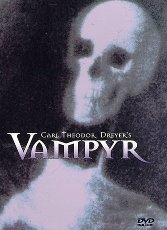 |
1.
Vampyr (Carl Dreyer, 1932).
It’s central to
Dreyer’s greatness that he had to reinvent cinema and film language
on his own terms, as if they had never existed before his own
features. This was never more true than on his first sound film,
which defines the uncanny in terms of film style as well as its
characters and settings, developing the already transgressive styles
of editing and camera movement in
The Passion of Joan of Arc
(Dreyer’s last silent picture) into something even more spatially
disorienting. |
|
For many years, prior
to the advent of videos and DVDs, most of Dreyer’s oeuvre was
achingly out of reach, especially in prints that did justice to the
carnal assault of his sounds and images. Now that this situation has
radically improved, the most conspicuous gap in our appreciation of
his work is a decent version of
Vampyr --in some respects his
creepiest and most erotic film (as well as his only foray into
fantasy and horror). What we now have on DVD is invariably something
cobbled together out of the separate English, French, and German
versions of the film that he prepared in Berlin (after shooting the
film silently in France), so that the same characters sometimes
shift languages without warning, and the visual quality is often
equally inconsistent. By all accounts, the best surviving version of
the film is Martin Koerber’s restoration of the German version, done
for ARTE Television in 1999, which reportedly runs a reel longer
than all other surviving versions, but this has yet to appear
anywhere on DVD. Let’s hope someone at Criterion and/or Masters of
Cinema is scheming to make this available.
|

|
2.
The Man Who Could Work Miracles (Lothar
Mendes, 1937).
It seems that the H.G.
Wells film that almost everyone has heard about is
Things to Come (1936), a rather grandiose SF
effort directed by William Cameron Menzies. But back in
the 50s when there were still double features on a
regular basis at some theaters, I caught
Things to Come playing with another British
movie adapted by Wells from his own work, made the
following year—a piece of very English whimsy that’s
also a serious fable about the tyranny of desire, at
once more modest and more cosmic than its predecessor. A
mousy young haberdashery clerk named George McWhirter
Fotheringay (Roland Young, better known as Topper) gets
picked at random by some quarreling gods in the starry
sky and, as an experiment, is given the capacity to
perform miracles, without offering him any explanation why.
(He can do just about anything in the physical world,
but he can’t alter how people think and feel.) Much of
what ensues is pretty funny, and made all the more
appealing by a fine supporting cast that includes Ralph
Richardson as blustery Colonel Winstanley, Joan Gardner
as the hero’s coworker Ada (whom he can’t induce to fall
in love with him), and even George Sanders in a bit part
as one of the quarreling gods. |
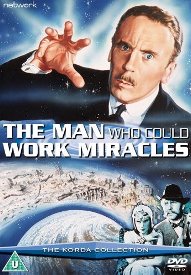 |

|
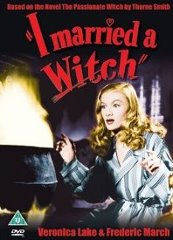 |
3.
I Married a Witch (René Clair, 1942).
After a prissy 17th century
puritan (Fredric March) fingers Jennifer (Veronica Lake), a leggy
blond witch who enticed him into a hayloft, she and her father
(Cecil Kellaway) get burnt at the stake, vowing in revenge that all
his descendents will have unhappy marriages. And so they do, until
the present--when their smoky essences are freed from an oak tree
and, once she’s back in human form, she sets about winning prissy
gubernatorial candidate Wally Wooley (March again) away from his
shrewish fiancée (Susan Hayward), contriving for him to rescue her
own naked body from a burning hotel.
|
This is a grand entertainment that first won me over
when I caught a revival at age six. For my money it has
more of Clair’s wit and poetry than any of his other
Hollywood pictures; and the fact that Preston Sturges
served as Clair’s (uncredited) coproducer on this comedy
and acquired Lake for it (fresh out of
Sullivan’s Travels) seems telling, because
it has a few noticeable Sturges touches. It was adapted
by many hands from
The Passionate Witch--a
novel left unfinished by Thorne Smith (of Topper
fame) when he died, and completed by Norman Matson. The
same novel served as the basis for the popular TV series
Bewitched and its less popular Nicole
Kidman spin-off, but for me this much earlier version of
the story comes a lot closer to getting it right. And
there’s something audacious as well as magical about
having Lake and Kellaway converse while they’re smoke
inside adjacent bottles; thanks to her deep, husky
offscreen voice, she contrives to conjure up a seductive
feminine aura of water, vapor, air, smoke, and flesh,
making me fantasize even as a first-grader about taking
a dip in the Lake of Lady Veronica.
|

|
4.
Pandora and the Flying Dutchman (Albert Lewin, 1951).
Reading
various reviews of Lee Server’s recent biography of Ava
Gardner, I was shocked to find the movie that defined
her apotheosis--surpassing even George Cukor’s neglected
1956 Bhowani Junction in its erotic splendor--
dismissed without a second thought. (It’s her first film
in color, and lusciously shot by Jack Cardiff--the
cinematographer on
The Red Shoes,
Under Capricorn, and
The Barefoot Contessa, a film clearly indebted
to this one.) This dismissal could never have happened
in France, where this masterpiece is available on DVD
and rightly revered as a summit for
producer-turned-auteur Albert Lewin (a kind of Val
Lewton on the six singular features he made, but with
the benefit of big budgets) and James Mason as well as
Gardner. (To commemorate what it meant to him as an
adolescent, Jean Eustache featured a lengthy clip from
it in Mes Petits Amoureuses.)
|
 |
|
In Susan Felleman’s lovely auteurist study of Lewin,
Botticelli in Hollywood,
she charts in detail the film’s Surrealist sources, ranging from Man
Ray (a friend of Lewin’s) to Giorgio de Chirico, and I think it
could even be argued that this movie is the supreme encounter
between Surrealism and Hollywood. (By contrast, the dream sequence
designed by Dali in Hitchcock’s
Spellbound is fairly drab and pedestrian.) So maybe part of
the discrepancy between continental and American responses to this
film is simply a matter of having a cultural context for the film’s
delirious and deliberate romantic excesses. The story is centered on
two mythical archetypes--Pandora (Gardner), an American chanteuse in
a small colony of expatriates in Esperanza, a village on Spain’s
Costa Brava circa 1930, who lures men to their doom, and the Flying
Dutchman (Mason), a mysterious and taciturn sea captain who arrives
one day. Condemned many centuries ago for the murder of his innocent
bride and for blasphemy, he’s obliged to sail alone in his ship for
all eternity unless he finds a woman willing to die for him. (This
film is almost precisely contemporary with Orson Welles’
Othello, and there’s an uncanny echo of a shot in which
Othello approaches Desdemona in her bed, when we see Mason in a
flashback approaching his own bride).
NOTE: Shortly after the preceding
was written and posted, Kino brought out a box set, "Glamour
Girls," containing Pandora and thus making it available
again in the US. |

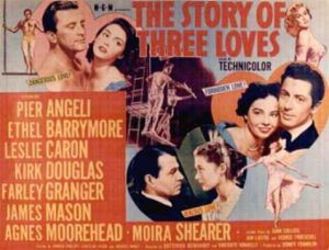 |
5.
Mademoiselle (Vincente Minnelli, 1953)
People
tend to forget nowadays that MGM was capable of making
glossy art movies in the early 50s. A prime example is
the star-studded
The Story of Three Loves, containing
three loosely connected 40-minute sketches—each one a
bittersweet parable about love and art, a compromise
between American fantasies about Europe and continental
émigré fantasies about the U.S., in which pop
existentialism serves as the main bill of fare. (If you
consider that 1953 was the year Jean-Paul Sartre’s
Being and Nothingness came out in English, this was
being pretty up to date.) |
|
If
someone had the wherewithal to bring this out on DVD, it
would be a major coup. The first and last episodes, both
directed by Gottfried Reinhardt (son of legendary German
stage director Max Reinhardt), told tales about a
ballerina (Moira Shearer) with a heart condition dancing
herself to death for a genius director (James Mason) and
about two guilt-ridden victim-heroes (Kirk Douglas and
Pier Angeli) in Paris who become a trapeze-artist couple
suspensefully gambling on each other.
Mademoiselle, directed by Minnelli, is the inspired
centerpiece and only fantasy. An 11-year-old American
boy (Ricky Nelson) in Rome who seems modeled on Daisy
Miller’s bratty kid brother hates his literary French
governess (Leslie Caron), but then he falls in love with
her after an obliging American witch in the same hotel
(Ethel Barrymore) enables him to turn into Farley
Granger for one enchanted, Cinderella-tense evening.
Miklós Rósza wrote the lush music, and Minnelli’s
magical feeling for dreamlike drifts is fully in place.
. |

|
6.
The Tiger of Eschnapur and
The Indian Tomb (Fritz Lang, 1959)
Lang’s
return to his German roots—-belatedly filming a
fairy-tale-like script that he and Thea von Harbou had
written during the silent era (and that had been filmed,
to his consternation, by Joe May rather than
himself)—-never had much of a chance to register in the
English-speaking world after the two features got
dubbed, drastically reduced in length, and cut together
into a single feature called Journey to the Lost City
that was critically greeted with scorn. These opulent
color films fared better with the public in Europe,
though Lang himself, perhaps embarrassed by their
unabashed directness, (in the lushness of their décor,
the eroticism of Debra Paget’s dancing with a cobra, and
the artificiality of certain effects, such as the cobra
being moved about with wires, became somewhat
dismissive of them. To accept their deliberately
childlike and somewhat kitschy innocence may require a
certain tolerance and trust on the part of the viewer,
but this luscious celebration and exploration of Lang’s
favorite tropes and themes fully repay the effort. |
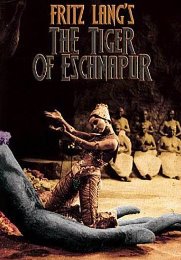 |
|
To the
best of my knowledge, these movies premiered in North
America in their original form only in 1981, when I
programmed them as part of a “Buried Treasures” series
at the Toronto Festival of Festivals, and outside of New
York, they never had a proper commercial run anywhere.
The ironic theme of my series was “bad movies”--by which
I mainly meant great, beautiful, and awesome movies that
had been misunderstood and were thus considered bad at one
time or another. (Other examples ranged from Leo McCarey’s
An Affair to Remember to Kon Ichikawa’s
An Actor’s Revenge to James B. Harris’s Some
Call it Loving to Elaine May’s
Mikey and Nicky.) But sadly, the only film I
considered truly bad, Edward D. Wood’s
Glen or Glenda?, was the biggest hit of my
series—-which seemed to suggest that beauty and
greatness weren’t what people wanted most from movies.
But if it’s what you’re looking for now, there are
glorious versions available on DVD. |

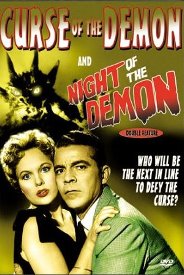 |
7.
Night of the Demon
(Jacques Tourneur, 1957).
Shot in
England, this is the
best horror film Jacques Tourneur made after his stint
in the 40s with Val Lewton which yielded
Cat People, I
Walked with a Zombie, and
The Leopard Man. And since none of these
films with the possible exception of the first really
functions as a horror film, except for in its ads,
Night of the Demon
might well be his greatest horror film; it’s
almost certainly the scariest. Neither Tourneur nor
screenwriter Charles Bennett wanted the title demon to
be seen, however, and bitterly complained when producer
Hal E. Chester insisted on inserting a few glimpses of
this beast. Like Clair above and Joe Dante below, among
others, Tourneur considered the audience’s imagination
one of his key artistic tools, and not allowing it to
function as fully as it might was actually depriving him
of something, not making any significant addition to his
bag of tricks. (A good example of Tourneur using our
imaginations is the sequence near the end where an
unidentified hand in the foreground appears on a stair
banister and is never explained or accounted for. This
hand, incidentally, belonged to Tourneur himself.)
|
A
fascinating, well-researched recent book about the
making of this film (Tony Earnshaw’s
Beating the Devil: The Making of Night of the Demon,
Sheffield, England: Tomahawk Press, 2005) suggests that
Chester, who brought in an old crony, blacklisted
writer-director Cy Endfield, to do additional,
uncredited work on the script, may have also gotten
Endfield to direct the added shots of the demon,
although the evidence supporting this is ambiguous. (For
whatever it’s worth, Endfield—whose masterpiece
Zulu is the focus of an even more detailed
and definitive book by the same publisher, also brought
out last year--once told me he did a rewrite of the
script that wasn’t used and thought he could have done a
better job directing the script that was used than
Tourneur, but said nothing about directing
any part of it.)
|

|
8. Confessions of an Opium Eater (Albert Zugsmith,
1962).
Is it excessive to include two Vincent Price opuses
here? (See
The Masque of the Red Death, below.) Maybe, but
this truly bizarre Z-film, also known as Souls for
Sale and Evils of Chinatown, is so off the
map that it scarcely qualifies as an alternate version
of anything--including the famous Thomas DeQuincey book,
Confessions of an English Opium Eater, that this
movie half-heartedly claims to be based on. As producer
and/or director, Albert Zugsmith was responsible for
some of the best and worst things to come out of
Hollywood. (Among the best were
The Incredible Shrinking Man,
Touch of Evil, The Tarnished Angels, and
this curiosity; among the worst were The Beat
Generation and The Private Lives of Adam and Eve.) |
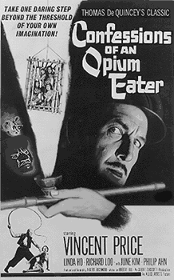 |
So it’s hard to know who or what to credit for the
strangeness of this low-budget effort, which starts off
like a tacky outdoor action thriller and becomes
progressively more dreamlike and inscrutable as it
proceeds into cramped interiors with its philosophizing
dialogue, its hidden rooms and secret passageways, and
its nearly all-Asian cast. The spirits of Louis
Feuillade and Fritz Lang? Screenwriter and associate
producer Robert Hill, whose other credits look pretty
undistinguished? Art director Eugène Lourié, whose other
films range from
Rules of the Game to
Shock Corridor? The eerie original, theremin-laden
score by Albert Glasser (Teenage Cave Man)? The
striking cinematography by Joseph F. Biroc (Forty
Guns)? Or some happy chemistry arising from the
encounter of some or all of these people with Zugsmith?
DeQuincey’s memoir was first published in 1822,
then reappeared in an expanded edition in 1856. Price
plays an obscurely motivated Gilbert DeQuincey, who may
or may not be a descendent, explaining offscreen that
about a hundred years after Thomas DeQuincey came to
London in 1802, he came to San Francisco’s Chinatown
during a Tong war. Kidnapped Chinese picture brides are
about to be auctioned off, some of whom he befriends,
but where he stands in relation to the warring factions
is never entirely clear. |

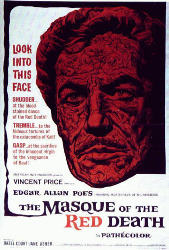 |
9.
The Masque of the Red Death (Roger Corman,
1964).
“If Poe had lived today he would probably have been a
filmmaker,” writes Diane Johnson at the end of her
Introduction to
Edgar Allan Poe’s Tales. This is
persuasive--even though it’s debatable whether Poe
himself would have made this adaptation (by Charles
Beaumont and R. Wright Campbell) of his lushest
apocalyptic tale. (Poe’s “Hop-Frog,” written seven years
later, is also woven in as a subplot--an understandable
addition, because the original “Masque” story consists
of little more than seven pages of moody description,
and most of the movie’s storyline doesn’t come from Poe
at all.) |
|
Nevertheless, this remains the most opulent and haunting
of Roger Corman’s Poe adaptations, shot in Pathécolor
and ‘Scope by Nicolas Roeg on some of the sets left over
from
Becket while creating a grimly coherent world of
its own, albeit with a few glancing nods to Ingmar
Bergman’s
The Seventh Seal (1957). We learn from Corman
on the DVD that John F. Kennedy was assassinated and the
Beatles had their first London premiere while this movie
was being shot (lead actress Jane Asher was dating Paul
McCartney at the time), and it’s a tribute to the film’s
atmosphere that the 60s ambience isn’t always front and
center, as it is with most Corman efforts of this
period. (For a hippie version of the Middle Ages, check
out John Huston’s neglected
A Walk with Love and Death
if you can find it, made five years later.) Vincent
Price plays evil and decadent Prince Prospero, Asher the
rebellious peasant he takes hostage, and Patrick Magee
is also on hand for some lively pre-Kubrick mugging. . |

|
10.
Martin (George A. Romero, 1977).
Romeo’s
second midnight-movie success after
Night of the Living Dead was his fifth feature.
It appeared around the same time as David Lynch’s much
better-known
Eraserhead, which may have muted its impact, and
it lacks the stripped-down action and cascading gore of
Romero’s other horror films. Yet as a kind of genial
shotgun marriage between James Thurber’s “The
Secret Life of Walter Mitty” and
Dracula, set in a Pittsburgh suburb called
Braddock, it has a sweetness about being a lonely
teenager that for me gives it a special place in
Romero’s oeuvre. In our 1983 book
Midnight Movies, J. Hoberman and I concluded,
“it is the most technically proficient of all his hits
and arguably his best film to date.” So it’s a pity that
his fascinating and more obviously satirical quartet of
Dead films has tended to overshadow this quieter chamber
piece, a kind of low-key comedy.
|
 |
|
John
Amplas plays the eponymous hero, and whether he’s an
actual vampire or a horny kid who imagines he’s one is a
question the movie repeatedly raises without ever
resolving. The continuity throughout between humdrum
reality and fantasy is especially apparent whenever we
hear Martin chatting as The Count on a late-night radio talkshow. |

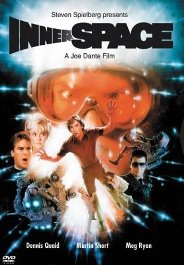 |
11.
Innerspace (Joe Dante, 1987).
Dante
has on occasion cited this as his personal favorite, but
many of his fans, myself included, have a tendency to
overlook it, maybe because it lacks the sociopolitical
edge that gives most of his best efforts a lot of their
bite (Gremlins,
Matinee,
The Second Civil War,
Small Soldiers, and
Homecoming, for instance). It also takes a
little while for this goofy comedy to get started—-that
is, just over 26 minutes to arrive at the point where
the central premise clicks into place. But then, for the
remaining 94 minutes, it’s pretty clear sailing. |
|
Much as
the conceit of Veronica Lake and Cecil Kellaway in
I Married a Witch (see above) being
represented by smoke in a couple of bottles is a triumph
of sound transforming image through the medium of our
imaginations,
Innerspace uses intercutting to convince us that
a brash, miniaturized Navy pilot (Dennis Quaid) driving
a sort of rocket ship accidentally gets injected into
the bloodstream of a hypochondriac supermarket clerk
(Martin Short) instead of a laboratory animal. Apart
from some Oscar-winning visual effects which underline
this curious state of affairs, this is basically a
matter of showing us Short and Quaid in separate shots
and asking our imaginations to fill in the rest, so that
fantasy is essentially created in the mind of the
beholder. This takes on more flavor and narrative
complications once Quaid and Short find they can address
one another and influence each other’s behavior and
actions (such as when they romantically compete, after a
fashion, for Meg Ryan). By the time various villains
also get miniaturized or semi-miniaturized (including
Kevin McCarthy and Fiona Lewis), the characters have
essentially taken over the movie. |

|
12.
Eyes Wide Shut (Stanley Kubrick, 1999).
I persist in regarding Arthur Schnitzler’s extraordinary
Traumnovelle better than Kubrick’s
long-contemplated adaptation, perhaps to the same degree
that I prefer Vladimir Nabokov’s
Lolita to Kubrick’s. And I differ with Kubrick’s
widow in considering
Eyes Wide Shut the apotheosis of Kubrick’s
career, even if he virtually completed it just before
his death, insofar as I actually prefer Steven
Spielberg’s realization of
A.I. Artificial Intelligence. But none of this
prevents me from cherishing Kubrick’s final
feature-—regarding it as the most misunderstood
masterpiece in his career, and therefore still awaiting
a measured and reasonable assessment from much of the
public. |
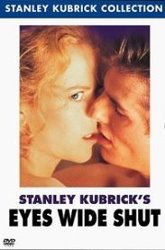 |
|
To call the film a fantasy is only to
half-understand it—and to complain that its
studio-built New York is “unconvincing” or that Sidney
Pollack’s lengthy speech near the end “explains” too
much is not to understand it at all. As the title itself
suggests, this is fundamentally a film about
fantasy--and not only the individual kind we entertain
as individuals, but also the more collective kind we
share with our relatives, friends, spouses, and
significant others. From this point of view, virtually
every scene and moment can be read in more than one way,
because by design the precise divisions between reality
and imagination in this picture are never precise. So
we’re being asked to navigate our way through the
story’s ambiguities to the same degree that the couple
played by Nicole Kidman and Tom Cruise is, and this is
something we, like them, have to do both by ourselves
and with others, comparing our own impressions as we
proceed. As Gilles Deleuze once put it, most of
Kubrick’s films are about brains breaking down. This
happens in
Eyes Wide Shut as well, but it might be said
that here, for once, the brain is shared by two
people—and manages somehow to heal itself in the nick
of time. . |
|












